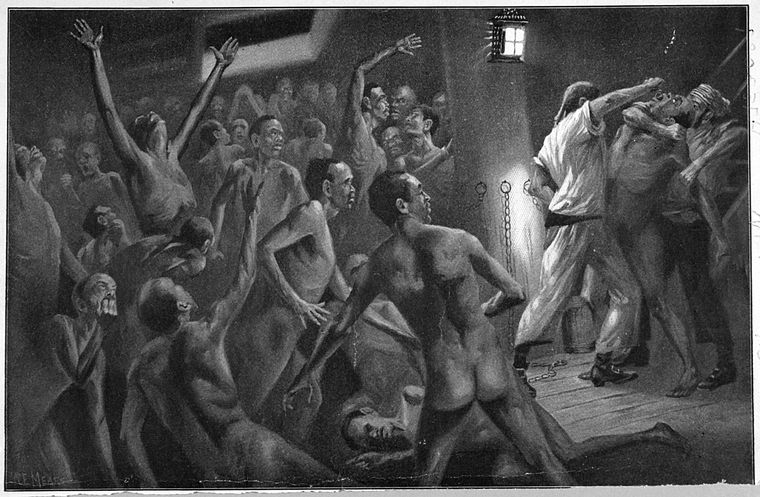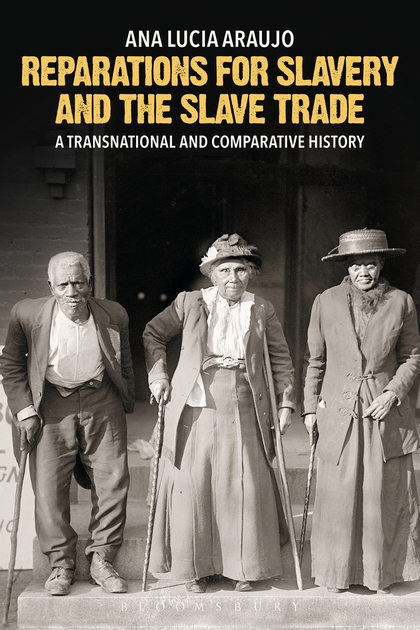Slavery and a Transnational History of Reparations

Reparations for slavery are arguably the biggest global question facing the African Diaspora in the twenty-first-century. In her new book, Reparations for Slavery and the Slave Trade: A Transnational and Comparative History, historian Ana Lucia Araujo offers a concise narrative of reparations from the eighteenth-century to the present. Utilizing sources in English, French, Spanish, and Portuguese, Araujo argues that contextual differences across the Diaspora dramatically shaped the nature and timing of reparative demands. While terminology varied, enslaved peoples almost always linked their emancipation projects to some form of repair. By bringing together the work of Mary Frances Berry, Charles Henry, Martha Biondi, Charles Ogletree, and many others, Araujo has cemented herself as a senior historian thoroughly in command of her craft.
Perhaps unsurprisingly, a book of this scale proceeds roughly chronologically. In addition to the U.S., nearly every country in Latin America and the Caribbean makes an appearance. While focused on reparations, the book also serves as a global primer on slavery and emancipation. Indeed, for Araujo, reparations, and their distinctiveness across space and time, can only be understood in light of the specifics of slavery. Time and again, she counterposes reparations for enslaved peoples against what she calls the “hegemonic view” of compensation for slaveholders after emancipation. (7)
While Araujo discerningly dusts off the tools of comparative history, the focus is thoroughly intellectual—tracing how Black people thought about reparations in different contexts. What immediately becomes clear is that the “transnational” promise in the book’s sub-title proves more aspirational than historical. For much of its history, reparations appeared largely confined (and defined) by national boundaries. While modern reparations advocates have been intentionally forging trans-Diasporic networks and narrating a shared historical past, this is something of an anomaly with apocryphal inclinations. Additionally, most reparations movements around the world emerged organically with little evidence that they were inspired by movements in previous generations. While this characterization may simply be a function of Araujo’s comparative (rather than transnational) framework, it appears more likely that the evidence to tell a truly transnational story simply does not exist.
So how were reparations imagined? Araujo offers several persistent features that seem to transcend her preferred deferral to spatial and temporal distinctiveness. First, Black women clearly lead the way. During the postemancipation period, as Black men were busy fighting for equality in voting rights, property rights, and citizenship, Black women (who were also pursuing these goals) worked on the even more transformative aims of healing and redress. While some scholars have theorized that reparations are ontologically a more nurturing, peaceful, and thus, supposedly more feminine demand, it seems more likely from Araujo’s evidence that Black women, like Callie House, turned to reparations because of their exclusion from traditional levers of power. Playing to patriarchal fantasies, Black women in the U.S. were able to position ex-slave pensions within the domain of Christian charity, Civil War pensions, and Black women’s club movements. This tradition of a democratic, horizontal, female-led organizing tradition runs straight through Araujo’s account beginning with Belinda’s Petition in 1783 to her profiles of Alicia Garza, Patrise Khan-Cullors, and Opal Tometi covered also by Barbara Ransby in Making All Black Lives Matter.
A second recurring theme in the history of reparations is its deep connection to Black socialism. While Callie House may have been arguing for an expansion of the social welfare state without explicit reference to socialism, Queen Mother Audley Moore and the Republic of New Afrika explicitly saw reparations as part of a wider socialist revolution. Likewise, James Foreman, Paul Robeson, and the Black Panther Party were all conceptualizing reparations through a global Marxist framework. Thus, the recent ideas floated by Cedric Johnson, Adolph Reed, and others who claim that reparations and socialism are somehow incompatible (or, even worse, that reparations represent a neoliberal plot where “identity politics” will supposedly divide the proletariat), appear patently untenable. Reparations are clearly an expression of socialism, not an obstacle to it.
Another major contribution is Araujo’s centering of Latin America. Most Americans are completely unaware that the equivalent of H.R. 40 has already happened in Brazil. In 2014 a nationwide truth commission investigated the possibility of reparations and found them essential to overcoming Brazil’s legacy of slavery. (174) Likewise, in the small republic of Ecuador, over a million Black residents are already experiencing the kind of state-funded reparations that many in the U.S. are fighting for. Racism in Ecuador was ruled a criminal act in 1979 punishable by jail time, thereby extending the anti-racism laws found in the U.K. (where racism is a civil offense punishable by fine). While many will rightly critique the punitive justice framework of such laws and their unintended expansion of the carceral state, their very existence proves significant. Building on this success, another Ecuadorian law passed in 2006 that moved from the punitive to the reparative allows for the creation of Black autonomous zones where Afro-Ecuadorians would be free to self-govern and form assemblies responsible for “proposing policies of social inclusion and reparation for Afro-Ecuadorians.” (158) This law was further codified in Equador’s Constitution of 2008, giving Black Ecuadorians the ability to claim communal ownership of traditional homelands just like indigenous populations. The possibility that a global movement for reparations is currently being normalized around the world is one of the key findings that Araujo beckons us to consider.
Perhaps the most important contribution of the book, however, went largely unspoken. Araujo suggests, rather off-handedly, that when formerly enslaved peoples demanded citizenship, what they were really conceptualizing was reparations. (3) This idea demands consideration. In the Latin American context, Araujo argues that mixed race people on the eve of emancipation already had a history of accessing some (if not all) of the rights of citizenship. Consequently, citizenship itself seems to have been the exclusive pathway through which newly emancipated peoples channeled their reparative demands. In the U.S., however, where national inclusion and a pathway to equal rights appeared significantly less likely, citizenship claims were augmented by explicit calls for financial reparations in anticipation that formerly enslaved peoples would remain a permanent underclass. In other words, the large presence of mixed race people in Latin America made the idea of full citizenship appear a more attainable goal for formerly enslaved peoples when compared to the somewhat more binary U.S. system. While I question the uniqueness of Latin America with respect to its mixed race population, the idea that full citizenship was conceived as a reparative act has the potential to dramatically rework the field. Additionally, citizenship as reparations looks very similar to emerging notions of ‘’transformative justice’’ that understand deliberate forward-looking action intending to repair historical harms as the gold standard of reparations. A transformed society in which the racial wealth gap, discrimination, inequality, and all manners of hierarchy have been eliminated is, after all, the end game of any socialist/reparations program.
But this brings us to the one major weakness of the book (which is really a weakness of the field more broadly)—the relative lack of a conceptual framework for reparations themselves. Araujo draws a distinction early on, for example, between symbolic and material (meaning financial) reparations (while stressing the latter). (2) She then goes on to suggest that (symbolic) apologies are the proper first step to pursuing financial reparations (5) but that symbolic gestures can also stand on their own as reparations. (2) While her critique of the anemic token gestures designed to bury rather than advance a comprehensive reparative justice program is admirable, most serious political theorists working on reparations have rejected any such distinctions between symbolic and material reparations. Any financial commitment to reparations would necessarily be only a symbolic gesture compared to the magnitude of the actual harm. Likewise, all symbolic measures require (and ideally lead to) significant material exchanges. As Shashi Tharoor is fond of saying in the context of reparations to India for British colonialism, any amount that is payable would not be sufficient and any amount that is sufficient would not be payable.
Yet even this formulation leads us right into the heart of the problem. The neoliberal frame that reparations opponents (and even supporters like Araujo and Tharoor) are apt to reproduce means that “proper” reparations are typically conceptualized as individual checks dispensed by supposedly legitimate nation-states into the hands of verifiable direct descendants of slavery (perhaps identified by some kind of blood quantum, genealogy, or other “scientific” measurement). In the world of international transitional justice and Peace Studies, however, practitioners, scholars, and theorists have, since the Holocaust, been developing a robust global praxis of reparations in places as diverse as Sierra Leon, New Zealand, Hawai‘i, and Argentina. In this world, reparations are not a project but a process. They represent a new global norm with the potential to eliminate our current legalistic punitive justice system entirely and replace it with a justice that is healing, unifying, and transformative. Reparations become not just a different way of doing justice, but justice itself. Attention to these sub-fields would have left this book significantly richer.
Overall, Araujo’s book offers a valuable contribution to scholars of the African Diaspora. While reparations may appear unattainable in our current political environment, Araujo reminds us that such odds have never stopped Black activists before. Indeed, sometimes all you have left is The Struggle.
Copyright © AAIHS. May not be reprinted without permission.
